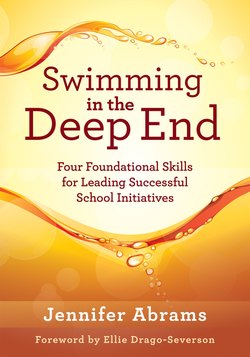Читать книгу Swimming in the Deep End - Jennifer Abrams - Страница 8
На сайте Литреса книга снята с продажи.
ОглавлениеForeword
By Ellie Drago-Severson
Jennifer Abrams has given us another gift—Swimming in the Deep End: Four Foundational Skills for Leading Successful School Initiatives. It is, for sure, a gift of love, born from her rich and deep experiences as a coach, international consultant, teacher, leader, and friend, working with leaders in schools, educational systems, health care, and various nonprofits around the globe. Throughout the book, Abrams encourages us to swim in the deep end by engaging with questions, using protocols, and employing practices she has designed thoughtfully and with dedicated intention. Each step of the way, she offers guidance—a roadmap—for how we can work individually and collectively toward making change by addressing and living the questions, and by learning more about ourselves and each other. Like most endeavors of great value, leading successful initiatives takes time, she explains. It takes hope. It takes trust. It takes patience. It takes care. It takes love. It takes dedication and commitment. It takes all of us. It is this kind of bringing together that Abrams seeks to support and achieve in this important work.
Specifically, Swimming in the Deep End focuses on knowing and understanding the challenges inherent in different initiatives so that our initiatives can make a difference. It also focuses on the importance of knowing one’s own and others’ values and paying attention to what schools and districts value as we implement important initiatives to bring about change and betterment. Throughout the book, Abrams offers many different kinds of learning lenses to help us understand these challenges and ourselves, so that we can more comfortably and confidently swim in the deep end as individuals and as a profession. The deep end, she wisely asserts, offers opportunities for us to grow and to help each other grow.
Not only does Abrams invite us to swim in the deep end and highlight the value of doing so, but she also shares courageously and powerfully some of the kinds of experiences we might consider—she calls these deep-end opportunities—that help us challenge and stretch ourselves and do the same for those in our care. Throughout her book, Abrams integrates and weaves together a tapestry of guiding questions, practices, and reflective questions that can help us to engage in four qualitatively different yet intimately connected foundational deep end skills that are linked to specific and vital internal capacities for leading successful school and system initiatives:
1. Thinking before we speak
2. Preempting resistance
3. Responding to resistance (for when we do speak)
4. Managing ourselves through change and resistance (after we speak) (p. 8)
Early on and throughout the book, Abrams reminds us that these are not only skills a person needs in and for the deep end, but also skills that will help each of us grow into fuller, more complete, and more effective versions of ourselves as leaders. This kind of stretching takes courage, Abrams notes, and her background as coach extraordinaire shines through especially clearly in the ideas, questions, and practices she offers to scaffold and support courageous change.
For example, as I read and reflected on the powerful chapters in Abrams’s book, I was—and continue to be—reminded of Rainer Maria Rilke’s (1993) thinking about questions:
Be patient toward all that is unsolved in your heart and try to love the questions themselves, like locked rooms and like books that are now written in a very foreign tongue. Do not now seek the answers, which cannot be given you because you would not be able to live them. And the point is, to live everything. Live the questions now. Perhaps you will then gradually, without noticing it, live along some distant day into the answer. (p. 34)
Managing this—learning to live the questions—requires the internal capacity to manage complexity and ambiguity. Abrams’s book helps us grow ourselves and in so doing it will help us support growth of others as well.
Abrams also reminds us of the critical significance of strong emotional, academic, and instructional supports—and how all of these are necessary for students and adults to lead and grow in schools and systems. Toward these ends, Abrams powerfully highlights that we don’t have to swim in the deep end alone. We need each other. We need each other to trust and be trusting. We need each other to build trust where trust has been broken. We need each other to become better communicators. We need each other to see deeper into ourselves and each other. Like mirrors or windows that reflect back new possibilities, trusted coaches, guides, and resources like this book can remind us of the power we have to transform ourselves and our systems, as well as the beauty and importance of pausing—whether it’s pausing to care for ourselves, care for others, smile, laugh, seek input, reflect on next steps, restore, or notice life every day.
For these reasons and more, Abrams’s words will reach right inside your heart, mind, and soul: “I want my colleagues, worldwide, to thrive,” she writes—on the first page of the book’s introduction (p. 1). This hope, motivation, and intention lives throughout the pages of this book. She shows us how to build a better world together with hope and love. And, like change, this is a book that requires time and considered reflection. I encourage you, with all my heart, to invest your time and care into learning from Abrams and her wisdom. It will be a cherished gift you give yourself.
